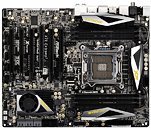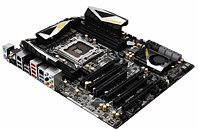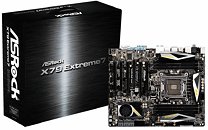Monday, October 10th 2011

ASRock X79 Extreme7 Pictured
ASRock is readying is new, high-end socket LGA2011 motherboard targeting the upper-most tier of the PC enthusiast market, the X79 Extreme7. This board will be a part of the company's first wave of LGA2011 motherboards, which are slated for mid-November, 2011. Pictures scored by XFastest reveal the board to be filled to the brim with features. The CPU socket is powered by a 16-phase VRM making use of high-grade chokes, and server-grade poscap capacitors.
The socket is wired to six DDR3 DIMM slots arranged in sets of three on either sides of the socket, powered by a 4-phase VRM. Among channels A, B, C, and D; channels B and D have two DIMM slots wired, so if you have four DDR3 modules, you should populate slots 0, 2, 3, and 5; to take advantage of quad-channel DDR3 memory. There are heatsinks over the memory VRM areas, that are connected to the heatsink over the CPU VRM using heat pipes.Expansion slots include five PCI-Express x16, two of these can run at full-bandwidth PCI-E 3.0 x16, four at PCI-E 3.0 x8 bandwidth (depending on how the slots are populated with add-on cards), one of these is wired to the X79 PCH and is PCI-E 2.0 x4 capable. There's a legacy PCI slot, too.
Storage connectivity includes four SATA 6 Gb/s ports, seven internal SATA 3 Gb/s ports, and one eSATA 3 Gb/s. Other connectivity options include six USB 3.0 ports (two on the rear panel, four via headers), 8+2 channel HD audio with optical and coaxial SPDIF outputs, two gigabit Ethernet connections, FireWire, and a number of USB 2.0 ports.
Source:
XFastest
The socket is wired to six DDR3 DIMM slots arranged in sets of three on either sides of the socket, powered by a 4-phase VRM. Among channels A, B, C, and D; channels B and D have two DIMM slots wired, so if you have four DDR3 modules, you should populate slots 0, 2, 3, and 5; to take advantage of quad-channel DDR3 memory. There are heatsinks over the memory VRM areas, that are connected to the heatsink over the CPU VRM using heat pipes.Expansion slots include five PCI-Express x16, two of these can run at full-bandwidth PCI-E 3.0 x16, four at PCI-E 3.0 x8 bandwidth (depending on how the slots are populated with add-on cards), one of these is wired to the X79 PCH and is PCI-E 2.0 x4 capable. There's a legacy PCI slot, too.
Storage connectivity includes four SATA 6 Gb/s ports, seven internal SATA 3 Gb/s ports, and one eSATA 3 Gb/s. Other connectivity options include six USB 3.0 ports (two on the rear panel, four via headers), 8+2 channel HD audio with optical and coaxial SPDIF outputs, two gigabit Ethernet connections, FireWire, and a number of USB 2.0 ports.



46 Comments on ASRock X79 Extreme7 Pictured
I seriously doubt you'll ever see the kind of motherboard design you're describing.
It has USB 3.
I'm a person that can't stand it when new tech comes out and we wait 1-2years before we use it. It just slows down our progress to new and better tech. If they make it why not just go all out, its better in every way.
Read the 2nd para and... well, need 4 or 8 not this 6 crap. besides, with density being pretty high, who needs 6 or 8?
I think it is a good idea to include 1 PCI slot during this long transitional phase to all PCI-E products
However, DOES IT CLOCK WELL??